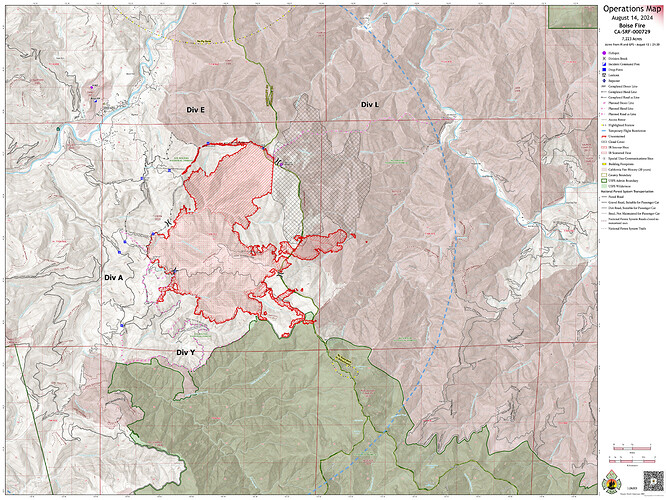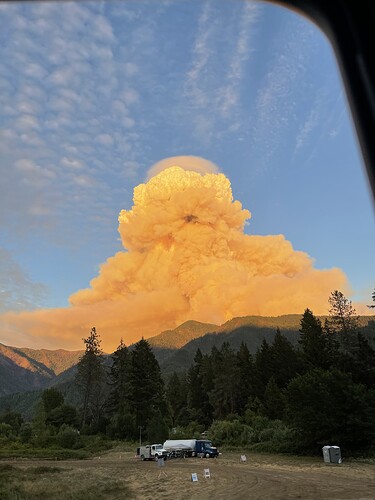It crossed Boise Creek and blew up the North Fork of Boise Creek. Some firing on a trail atop the ridge showing at 9:30pm, last night, with a large slop over, but it will bump last year’s Pearch Fire on the other side of the ridge. Some of the ‘weird fingers’ are firing ops.
Maps and commentary here:
Where is base camp?
Camp is in Orleans.
Thanks, amazing pictures
Any cal fire presence on this fire?
None that I’ve seen or heard but that could always change
8/14 Info:
7,223 acres @ 0% containment
610 Personnel Assigned
CIIMT 10 has the fire
Point Weather Forecast for Today
Critical Resource Needs:
STEN Type 3 - 2
DIV - 2
TFLD - 5
HEQB - 5
Falling Module - 3
RADO - 3
Crossband Repeater - 1 NIFC
SOFL - 2
SOFL1 - 1
EQTR (Q) - 1
LTAN - 1
Ops Map:
Based on many compounding factors particularly the very recent fire’s explosive growth, wild rough topography and extensive fire perimeter burning in heavy fuels, the few listed, needed critical resources is VERY ALARMING. What is the strategic plan for suppressing the Boise Fire?
Keep in mind this is from the 209 submitted to NOPS. The team is ramping up and there are many factors in what is put into the “Critical Resources Needs” box on the 209. Use this info as an indication as to what they are “officially” asking for keeping in mind that yes, the Team may want/need much more than what is listed, but based on current op area situation, status of resource availability, timing out resources, competing incidents, contractor availability (think logs for showers, food, sanitation, etc) all come into play.
With that said, take the 209 info with a grain of salt…
Chief,
The fire is wrapped on the south side by a 2020 Red Salmon Complex, on the north by the 2023 Pearch Fire, and it is backing into the 2013 Butler Fire on the east. The west end/heel has largely held for 2 days, and many folks seem alright with the idea of letting the fire back down thru the 2013 Butler Fire and fighting it at the Salmon River road corridor.
Green line is 14:30 mapping from yesterday, red is 21:30 IR.
We took a deep dive into local perspectives on firefighting on our Lookout Livestream a couple days ago.
If the 209 is to be taken with a “grain of salt” then salt is all you will get from NOPS. The 209’s are evaluated everyday( twice actually) and resources are assigned based on incident priority which is derived from the 209.
Some of it is the broken federal resource ordering system which ties the hands of the IMT’s. The federal IMT’s need to be supported better with everything from better catering to being able to use the closest resource concept rather than equipment on contract from three states away.
Priority decisions and related are also based on a series of conference calls that occur each day, where the top dogs at the GACCs ask the Team key players pointed questions about what is going on with their fires.
Everyone knows 209s have some value, but hearing the sitrep from the horse’s mouth is much more informative.
Not sure if you have been through 420 but it is clear that the 209 is what is graded. Agree the CC takes place but everyone is going to “upsell” their incident… but when it is put in writing and the critical resource needs are listed that is how they get filled when things become available.
Well…I have sat in on a number of the conference calls, including while actually being in North and South Ops.
So we can skip the 4:30 am call to update the 209 each day? I am in.
No
209 sets baseline need and resources requested, conference call allows for additional clarification and teasing out the actual need. Some teams have really good 209 writers, others not so much.
Let’s keep this tracking on the Boise Fire, please. If we need to have a breakout thread for resource ordering priorities, we can certainly do that
Fire955, Thank you very much for the information. I appreciate and value the ICS Form 209 priority setting process, etc. and am well experienced with the process. Info, I have 40 years as a qualified ICT1 and OSC1.
Sounds like the Boise Fire is not a full suppression fire. If so, a limit should be set on allocated resources. Attention must also reign with the impacts of respiratory illness and cancer from wildland smoke which is well defined by UCLA research.
From MS Copilot: " UCLA has conducted significant research on the effects of wildland fire smoke. A recent study published in the journal Science Advances found that inhaling fine particulate matter (PM2.5) from wildland fires led to between 52,500 and 55,700 deaths in California over an 11-year period from 2008 to 201812. This study also estimated the economic impact of these health effects to be between $432 billion and $456 billion12.
The research highlights that long-term exposure to wildfire smoke is becoming an ongoing problem, contributing to chronic disease formation1. The study’s lead author, Rachel Connolly, emphasized the need for investment in forest management and climate mitigation to reduce these health impacts1."
8,617 acres



